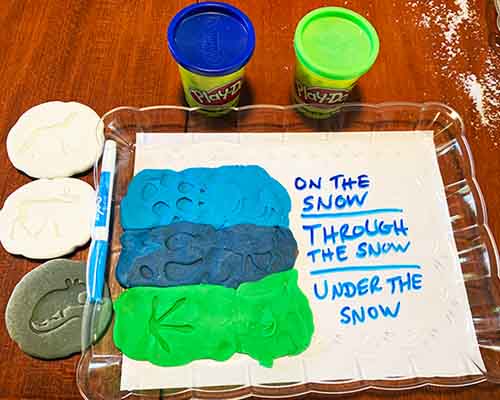Wild Winter

Preschool Winter Activities
During the cold winter months, introduce this scientific preschool winter
activity into your classroom or home to extend seasonal STEM learning.
By Hollie Barattolo
Preschool Winter Activities
During the cold winter months, introduce this scientific preschool winter activity into your classroom or home to extend seasonal STEM learning.
By Hollie Barattolo
Ages/Grades
Preschool, Early Elementary
Learning Domains
Science, Fine Motor
Materials
- • Footprint stones, animal figures or laminated photos of animals that walk through snow and ice.
- • Insta-Snow in a tray or bin (damp sand or kinetic sand will also work)
- • Modeling dough or clay (optional)
Ready, Set, Go!
 Talk about walking through snow. Students can share personal experiences or impressions they have gotten from movies or books.
Talk about walking through snow. Students can share personal experiences or impressions they have gotten from movies or books.- Essential questions: Can you walk on top of the snow without sinking down? Could you wear something on your feet to stop you from sinking? What do you leave behind you when you walk?
 Pass out the animal examples you will be using for the experiment. Make observations about animals that either stay awake during the winter or come from places that have lots of snow.
Pass out the animal examples you will be using for the experiment. Make observations about animals that either stay awake during the winter or come from places that have lots of snow.- Compare:
Coverings (fur, feathers, scales)
Feet (hooves, flippers, paws)
Sizes (big/small, heavy/light)  Make up a tray or bin of insta-snow and let the students experiment making tracks with the stones or plastic animals.
Make up a tray or bin of insta-snow and let the students experiment making tracks with the stones or plastic animals. Smooth the ”snow.” Find an animal that is light enough and has feet that work for standing on the snow. (rabbits, foxes, birds) Practice making light tracks on top of the snow.
Smooth the ”snow.” Find an animal that is light enough and has feet that work for standing on the snow. (rabbits, foxes, birds) Practice making light tracks on top of the snow.- Essential questions: Are these animals heavy or light? What do you think they might eat? What might eat them? If the snow was really deep, do you think their tracks would change?
 Find an animal that is heavy and has to walk through the snow. Push that animal to make troughs through the snow. (caribou, deer, moose) Pretend to be a second animal and walk that animal through the same “footsteps” as our first animal.
Find an animal that is heavy and has to walk through the snow. Push that animal to make troughs through the snow. (caribou, deer, moose) Pretend to be a second animal and walk that animal through the same “footsteps” as our first animal.- Essential questions: Are these animals heavy or light? What do you think they might eat? What might eat them? Why might they walk in a line? Is the snow as deep for the second animal? How are their feet different than the feet of the animals that go on top of the snow?
 Find an animal that goes under the snow. (mice, shrews, voles) Practice burrowing under the snow with those animals.
Find an animal that goes under the snow. (mice, shrews, voles) Practice burrowing under the snow with those animals.- Essential questions: Are these animals heavy or light? What do you think they might eat? What might eat them? How would they get under the snow? Could other animals find them under the snow? How are their feet different than the feet of the animals that go on top of and through the snow? Which animal would you want to be?
Extension
- Lay three stripes of clay on a tray. The top stripe will be for animals on top of the snow, the middle stripe will be for animals that walk through the snow, and the bottom stripe will be for the animals that burrow under the ice. Make impressions in the clay according to how the animals would move through snow. Label and let dry.
 Hollie is certified K-8 teacher who has been educating in the informal education field since 2005. She has developed and implemented countless exciting STEAM programs for families, classrooms, and teachers focused on the natural world, the scientific process, and ancient life. Her professional passions are inquiry, whole family learning, experiential learning starting in early childhood, and the intersection of literacy and science instruction.
Hollie is certified K-8 teacher who has been educating in the informal education field since 2005. She has developed and implemented countless exciting STEAM programs for families, classrooms, and teachers focused on the natural world, the scientific process, and ancient life. Her professional passions are inquiry, whole family learning, experiential learning starting in early childhood, and the intersection of literacy and science instruction.
She has recently developed a community-based program that encourages families to use dramatic play to learn science, increase literacy skills, and have fun together for which she received the Drexel University Presidential Award for Civic Engagement. She is most proud of her work on a popular science storytelling program for preschool families and classrooms that combines a book club format with engaging programs, innovative curriculum, and a hysterical puppet storyteller.
